

|
|
|
|
|
|
|
|
|
DRUM BUILDING METHODSThere are at least five ways to build a drum out of wood. They all have their pluses and minuses. The five methods are:Ply Stave Segmented Steam Bent Solid You can also build a hybrid drum out of several different materials. Hybrids Each of these links will take you to a page with details and in-depth discussion on that method of building a drum. Listed below is a quick overview of the methods. |
Building a Ply Drum |
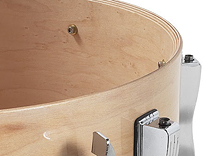
|
|
Basic description: This is the method most commonly used by the big drum companies. You build a mold (usually a female) that is to the size of the outside diameter. Take thin sheets of wood known as plies, place them inside the mold with glue on every surface that will touch another ply. Apply pressure by tightening your mold. Some builders also apply pressure from the inside out using an inflatable gym ball or something similar. When dry, release the mold and your shell is ready. Advanced builders will make their own plies from very thin sheets of laminate. The plies a beginner should build from will already have several layers of laminate together within their ply sheets. Note that not everyone uses the terms "ply" and "laminate" in the same way. Pluses: Economical Requires few special tools Once the mold is made, shells can be turned out relatively quickly and easily. If you use a female mold you can add to the thickness a little at a time, as much as you like. Easy to make a thin shell. Flexible which aids durability. Suitable for mass production. Minuses: Limited wood selection Uses more glue which some people believe affects the sound in a negative way. More likely to go out of round than stave method. Special tools required: Router (to make the mold and to cut the bearing edges) For more information on this method go to: Building a Ply Drum |
Building A Stave Drum |
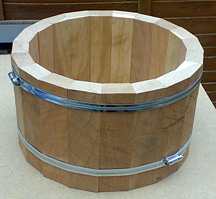
Drum by firefly |
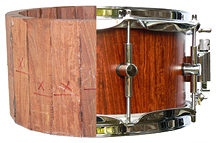
Drum by Koko |
|
Basic Description: This is the method most commonly used by custom builders. Built similarly to a barrel, the wood pieces are vertical with bevelled edges arranged to form a circle. The staves are glued and clamped. When the glue is dry the outside and inside are lathed to achieve a smooth, round shell. Pluses: Many exotic wood varieties are available. Grain is vertical which some believe produces a better tone. Uses less glue than ply which some believe enhances the tone. This is an issue of some debate, but there is no denying that it has its own distinctive sound. Easy to make into thick shells. Not likely to go out of round because the wood is not being stressed into shape. Ideal for making mixed wood shells. Minuses: Wood is more costly than ply. Requires more special tools than the ply method. In particular, some sort of lathe or router is needed to round the shell. Not a good method for making a thinner shell. Special tools required: Router or table saw to bevel the staves (router also needed for bearing edges). Lathe needed for rounding the shell both inside and out (after glue up). Or a special jig can be made with a router - see Koko's Stave Drum Without a Lathe sticky post in the General Building section of the Drum Shed forum. For more information on this method go to: Building a Stave Drum |
Building a Segmented Drum |
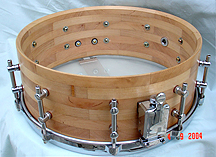
Drum by guguinet |
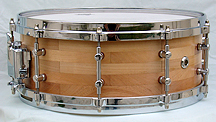
Drum by guguinet |
|
This is not a very common method of building although it makes a perfectly fine shell. They are built almost exclusively by custom builders and are similar to staves in a lot of ways - in fact, they can be thought of as many rings of smaller staves. The advantages and disadvantages are also somewhat similar to staves. Basic description: Small horizontal pieces are cut with beveled edges to form a circle which is glued and clamped. Several rings are made this way. The rings are then placed on top of each other (with joints offset) and glued and clamped. When the glue is dry, the outside and inside are lathed or routed to achieve a smooth, round shell. Pluses: Many exotic wood varieties are available. Can be made from smaller pieces of wood than stave method. Grain is horizontal which some believe doesn't produce the best tone, although this is highly debated. Uses less glue than ply but more than staves (because it has smaller pieces). It's easy to make thick shells. Not likely to go out of round because the wood is not being stressed into shape. Ideal for making mixed wood shells. Individual segments can be cut with a miter saw (unlike staves) because they are not very tall. Minuses: Wood is more costly than ply. Requires more special tools than the ply method. Not a good method for making a thinner shell. More time consuming to make the segments (compared to staves). Biggest complaint seems to be that they look too much like hardwood floors. Special tools required: Router or table saw or miter saw to bevel the staves (router also needed for bearing edges). Lathe needed for rounding the edges of the staves. (Or special jig can be made with a router - see Koko's Stave Drum Without a Lathe sticky post in the General Building section of the Drum Shed forum.) For more information on this method go to: Building a Segmented Drum |
Building a Steam Bent Drum |
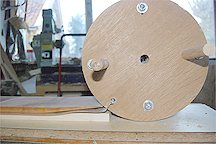
|
|
Steam bent shells are considered among the most desireable because of their acoustic properties and simplicity of design. However, they are not easy to build, and as a result, most builders choose a different method. Because of this, there is far less information on how to build them than other methods. Basic description: Also sometimes called 1 ply shells, steam bent shells are made from a single piece of wood. A special box is made to produce and control moisture and the piece of wood is placed inside and carefully monitored. After the right amount of moisture is achieved, the wood is removed from the box and wrapped around a mold. They generally have a scarf joint which is glued together to complete the circle. (For more info on scarf joints see:http://en.wikipedia.org/wiki/Scarf_joint) Pluses: More wood types are available than the ply method. Uses hardly any glue at all. Considered by many to have great sound, although this is subjective. The legendary Radio King snare was built using this method. Minuses: Perhaps the most difficult to keep in round. Because of this, they often have reinforcement rings. Limited shell thickness - difficult to make thin or thick - needs to be somewhere in between. Grain is horizontal which some believe doesn't produce the best tone, although this is highly debated. Not as much information on how to build them because fewer people use this method. Special tools required: A box where moisture can be added, controlled and measured. A mold around which the wood can be wrapped and a method of applying the pressure. For more information on this method go to: Building a Steambent Drum |
Building a Solid Wood Drum |
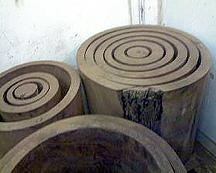
Drum by meinl_aa |

Drum by digidrums |
|
You almost never see one of these but for many they are the holy grail of drum shells. They are made from a tree trunk which is
hollowed out and made into the shape of a drum - so there is no joint of any kind, and therefore, no glue. The picture
on the left shows a unique attempt to get many sizes of shells from one tree trunk.
Basic description: Begin with a large piece of a tree trunk and hollow it. If you need to store it awhile before beginning your project, it is essential that you paint or wax the cut ends and drill a hole through the center so that it dries evenly inside and out and doesn't crack. Store or kiln dry until the proper moisture content is achieved - this varies depending on what part of the country you live in. Then lathe inside and outside into finished shape. Pluses: The wood is in its natural state - there is no pressure on it to change or come out of round. There are no joints or glue needed. Unique. Rare. Minuses: Hard to find suitable wood. Trees need to be very large and pieces have to remain uncracked during the drying process. Because few people use this method, there is little information on how to do it. Requires more special tools than the ply method. Not a good method for making a thinner shell. Special tools required: Router for bearing edges. Some sort of creative method of hollowing them out. Lathe for rounding. (Or special jig can be made with a router - see Koko's Stave Drum Without a Lathe sticky post in the General Building section of the Drum Shed forum.) For more information on this method go to: Building a Solid Wood Drum
|